Mee Rebus is Malay Hawker Centre fare. It’s a delicious bowl of egg noodles in gravy, topped with all the usual suspects: eggs, tofu, chillies and limes. This is just the way my granny used to make it.
Estimated reading time: 7 minutes

What’s in a Name?
Mee Rebus is what these noodles are called in Malay. Literally translated:
- mee = noodles in Malay as well as Hokkien, a Chinese dialect
- rebus = to boil, boiled in Malay
We have sooo many noodle dishes in East and South East Asia, you could spend a whole year eating them and still not exhaust your choices. Mee rebus is just one of many noodle dishes found in Singapore and Malaysia alone. There’s also Bak Chor Mee, Mee Siam, Mee Goreng Mamak, Hokkien Mee, Kway Teow – the list is practically endless!
Why is it called boiled noodles in Malay? I couldn’t tell you – no one seems to know. Whether it’s because we blanch the noodles and beansprouts in boiling water (very common practice) or because the gravy is simmered away, who knows. If you do, by all means, drop me a line.
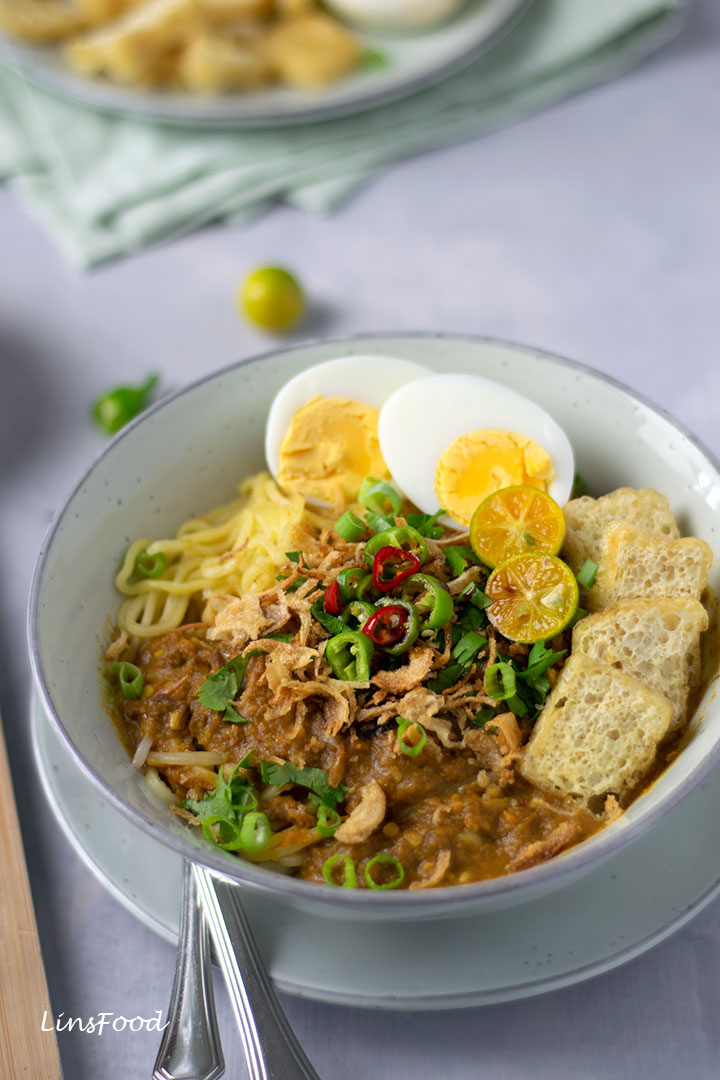
Homemade Mee Rebus
Ok, there are no 2 ways about it – this recipe takes some effort. Some Asian noodles are quick and easy, some, let’s face it, you want to clear a day for!
You can console yourself with the fact that it took me ages to get this post done, for that very fact!
Sure there are always shortcuts and who doesn’t love quick and easy recipes? As a widow with 4 homeschooling kids, I embrace them, but there are just some traditional recipes, that I refuse to cut corners with. I know many of you who are no longer living at home (wherever that may be), will agree.
So while our mee rebus recipe is pretty straightforward once you see the steps involved, it does take a little elbow grease. Like many wet noodle dishes, there are a few moving parts to it. This is what we’ll be doing:
- boil and mash sweet potatoes – they are what we use to thicken the gravy. Regular potatoes may be used, but won’t quite have that sweet, aromatic flavour.
- dry toast skinned peanuts, then grind them – these are to thicken as well as flavour the gravy. You could substitute this with smooth peanut butter.
- grind all the paste ingredients.
- make the gravy and leave to rest for 2 hours to let the flavours develop. This, to me, is an advantage, as much of the work can be made ahead. In fact, I always make mee rebus gravy the day before and keep it in the fridge overnight.
- prepare all the noodle toppings: boiled eggs, lime wedges, fried tofu (can be bought), crispy onion slices (can be bought) sliced chillies, spring onions (scallions) and a little sambal, if you like.
- blanch the noodles and beansprouts and serve.
I love serving noodle dishes like this one as party food. You prepare everything, then lay it all out on the table and everyone helps themselves to the various toppings, as they fancy.
Mee Rebus Ingredients
Let’s take a quick look at some of the ingredients. You know if you are going to cook the recipes on this site, you will have to source out the ingredients we use regularly. Find an East Asian store and you should be fine. Otherwise, online shopping is the way to go. Amazon and Ebay sellers are always a good bet.
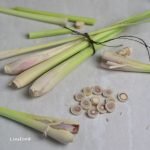
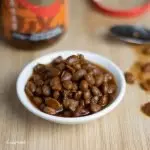
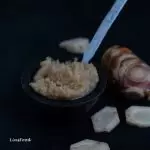
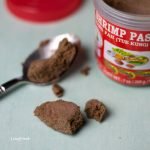

Lemongrass (Serai)
I think this should be fairly easy to find these days. Here in the UK, all our large supermarkets sell them, both fresh and in jars. If you can only find the dried version, double the amount, soak them in very hot water, then add to the chopper, reserving the soaking water for the mee rebus gravy. Click here to read more about lemongrass.
Salted, Fermented Soy Beans (Taucheo)
Taucheo are salted and fermented soy beans. They add a salty, earthy, slightly smoky element to dishes. Dark red miso paste can be used as an acceptable subsitute. Failing that, hoisin sauce will do in a pinch. Click here to read more about taucheo.
Galangal (Lengkuas)
A tuber with sweet and floral notes, galangal has no substitute, so to cook Singaporean and Malaysian (and Thai and Indonesian), you absolutely must have this in your pantry. In the UK, you’ll find jars of the paste in Sainsburys, Waitrose, Ocado and Tesco. It can be bought fresh at many, many online stores. Google is your friend. Or Bing!
Galangal is a natural accompaniment to lemongrass, and these two are often used together. Galangal stores well, so buy lots and keep them in the freezer until needed. Or make your own paste with water or oil and freeze. Click here on how to do that and to read more about galangal.
Shrimp Paste (Belacan)
This is fermented and dried tiny shrimps. It’s one smelly ingredient. I love it and cannot live without it. It imparts incredible depth to dishes, and must be used conservatively, as too much can be overpowering. Belacan is often used alongside dried shrimps, as in today’s mee rebus, for a double umami hit.
Here in the UK, you can find this in larger supermarkets. I shop with Ocado, and they certainly stock them, as does my local Waitrose. Click here to read more about belacan.
Dried Shrimp (Udang Kering)
Dried shrimp are just that – tiny shrimps that have been dried in the sun. There are a few varieties in terms of size. They are salty and smell of the sea, and add depth to dishes. These can be found in specialist stores. As long as they sell Chinese, Korean or Japanese food, they’ll stock dried prawns.
The Noodles
The noodles used in mee rebus are fresh yellow wheat noodles. Again, in the UK, they are sold in all our large supermarkets. If you can’t get the fresh variety, use any dried egg noodles and follow the cooking instructions on the back of the packet, then serve up.
Use wheat free noodles for gluten free mee rebus.
The Beef
This is the only change I’ve made to my grandma’s recipe. She would use tiny pieces of chopped up meat. I long ago switched to mince because I’m lazy like that.
Can you leave the beef out for mee rebus? Yes, you totally can. You could even use tiny pieces of chicken, if you like.
However, leaving the meat out will not give you vegetarian noodles, as we’ve got dried shrimp and shrimp paste in the ground ingredients. You could leave those out, but by doing that, I personally think there’s hardly any point in making it!
Before my kids went vegetarian, I used to make this without the beef as they weren’t keen, with egg free noodles (my girls have an egg allergy). But now, I just don’t bother. I make a small amount a couple of times a year, and satisfy those childhood cravings. There are plenty of other noodle dishes that can be made vegetarian without losing too much.
Toppings and Garnishes
Noodles are never quite complete without their various toppings and garnishes. Whether it’s today’s mee rebus, Japanese ramen, Thai pad thai, or any other noodle dish, what you finish it with is almost as important as the noodles themselves.
So, to complete our Malay noodles today, we’ve got a gamut of toppings, like some homemade sambal belacan. Some can be shop bought and any extra stored in the freezer or pantry, unless you fancy a little DIY. I know it’s a lot of work, but if you love your hawker centre noodles as much as I do, it’s totally worth it!
And I think that about covers it. Shall we get cooking?
♥ If you like the recipe and article, don’t forget to leave me a comment and that all important, 5-star rating! Thank you! ♥
And if you make the recipe, share it on any platform and tag me @azlinbloor, and hashtag it #linsfood
Lin xx
More Malay Recipes
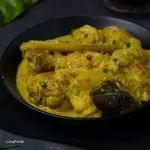
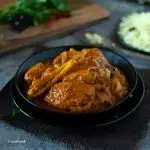
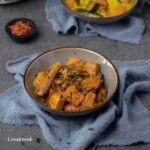

Mee Rebus Recipe
Ingredients
- 1 sweet potato, medium (keledek)
- 60 g raw peanuts (kacang tanah) or 2 flat tablespoons smooth peanut butter
- 500 g fresh egg noodles (mee kuning) or about 200g dried noodles
- 100 g beansprouts (taugeh)
- 100 g minced beef (daging cincang)
- 1 litre water (air)
- 2 tsp salt (garam)
- 1 Tbsp sugar (gula) omit if using peanut butter
- 3 Tbsp vegetable oil (minyak)
- 2 stalks lemongrass (serai)
Mee Rebus Spice Paste (Rempah)
- 1 large brown onion (bawang besar)
- 1 stalk lemongrass (serai)
- 5 cm galangal (lengkuas) OR 2 tsp shop bought paste
- ½ Tbsp shrimp paste (belacan) no toasting required
- 2 Tbsp dried shrimp (udang kering) no soaking required
- 4 Tbsp taucheo
- 3 Tbsp mild curry powder (serbuk kari) any generic Indian style will do
Toppings and Garnishes (as many as you want, I have them all!)
- 6 eggs (telur)
- 200 g firm tofu (tahu) or use shop boought puffed tofu as I sometimes do
- 60 ml vegetable oil to fry the tofu (minyak)
- 3 limes (limau) I'm using "local" calamansi limes, as I grow them (limau kasturi)
- crispy fried shallots (click for DIY recipe on LinsFood) I just use shop bought ones
- 2 fresh red chillies (cili merah) any variety, mild or hot, up to you
- 2 fresh green chillies (cili hijau) as above
- 2 stalks spring onions (daun bawang) (scallions)
- 3 sprigs fresh coriander leaves (daun ketumbar) (cilantro) optional
- sweet soy sauce (kicap manis)
Instructions
Sweet Potato
- Bring a medium-sized pan of water to boil.
- Peel and chop the sweet potato into cubes and drop them into the pan, with a tsp of salt. Bring back to a boil, then simmer for 15 minutes until the sweet potato is well done.1 sweet potato, medium (keledek)

- Drain then mash the sweet potato cubes and set aside until needed.1 sweet potato, medium (keledek)
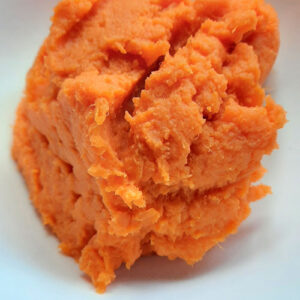
Peanuts (skip this if using peanut butter)
- Place the raw or blanched peanuts in a small frying pan over medium heat and toast for 5 minutes. Turn the heat down to medium-low after 2 minutes, so the peanuts don't brown too quickly and burn. Keep tossing and flipping the peanuts until they are a light brown colour and giving off a sweet and nutty aroma.

- When done, tip the nuts onto a large, flat plate and leave to cool for for at least 15 minutes or once you've got the mee rebus gravy going.
- Place the toasted peanuts in a chopper and pulse to a fine state. Set aside to thicken the gravy.

Mee Rebus Paste
- Peel and quarter the onion and drop into your chopper.
- Slice off the tough bottom end (the root end) of the lemongrass. And cut off the top part, leaving about 10 cm/4 inches of stalk. Peel off the top layer, if it's particularly dry or dirty, or looking a little yellow. Rinse your lemongrass and dry. Using a sharp knife, slice your lemongrass into thin rings, then add to your chopper. Slicing your lemongrass makes it easier to be ground, as it is fibrous by nature.

- Cut off the tough outer layer of the galangal and discard.Slice the galangal into thin rounds and place in the chopper.
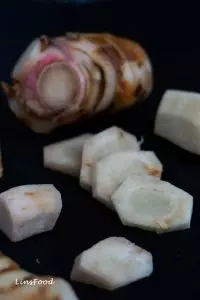
- Add all the other paste ingredients into the chopper and grind to a fine paste. So that's the shrimp paste, dried shrimp, taucheo and curry powder. Add a little water if you need it.
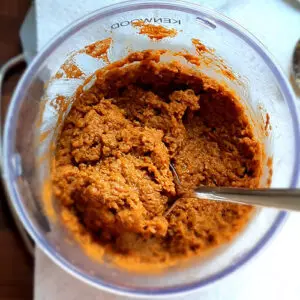
Mee Rebus Gravy
- Slice off the tough bottom ends (the root end) of the 2 stalks of lemongrass that are left. And cut off the top part, leaving about 10 cm/4 inches of stalk. Peel off the top layer, if it's particularly dry or dirty, or looking a little yellow. If not, leave it alone. Rinse your lemongrass and dry. Place your lemongrass on a chopping board and bash hard on the thick end with the back of your knife. This is called bruising your lemongrass.
- Now heat the 3 Tbsp of oil in a large saucepan over medium heat and fry the ground paste and bruised lemongrass for 2 minutes.

- Add the beef and mix well, breaking up the mince with yuor ladle. Fry the beef for 1 minute. Don't worry too much if it's on the dry side.

- Add the water and 1 tsp of salt, mix and bring to a boil.

- Lower the heat, cover and simmer for 30 minutes.
- At the end of 30 minutes, add the sugar and ground nuts.

- Lighten the mashed sweet potato with 2 ladles of the gravy, mix, then add that to the pot too. This will allow to mash to mix easier, instead of giving you lumps of mash.

- Simmer uncovered for 5 minutes. Then check the seasoning, add more salt if you want. If the gravy is too thick, add a little more water and check seasoning again.

Other Prep Work (while the gravy is simmering)
- Boil the eggs. Then cool, peel and halve.

- Chop up the tofu into cubes and fry in oil over medium heat for 5 minutes, tossing to brown slightly all over. You are going for a golden brown colour. Drain onto a kitchen paper lined plate.
- Slice the chillies, halve the limes (or cut into wedges), chop up the spring onions thinly and the coriander leaves finely. Set aside.
- Bring a large pot of water to boil. Add 1 Tbsp of salt. Drop the noodles in and cook for 1 minute. Drain, reserving the water, as we'll need to do the same to the beansprouts.I use a deep noodle strainer and hang it off the side of the pot and just lift ot our when the noodles are done.

- Repeat the blanching with the beansprouts for a minute too. Drain and set aside.
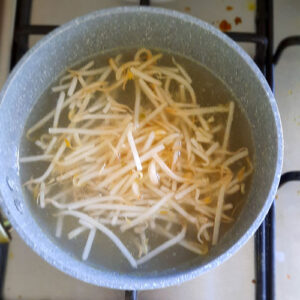
To Serve
- Get 6 large noodle bowls, or however many you are serving.
- Divide the noodles into the bowls.

- Top with beansprouts.

- Ladle a generous amount of gravy all over.

- Then top with whatever garnish you have prepared or fancy, as in the images on this page. Be as conservative or generous as you like.

- Finish off with a squeeze of lime as well as a small drizle of kicap manis. The kicap manis is usually only drizzled over the chilli slices.

6 thoughts on “Mee Rebus (Malay Hawker Centre Egg Noodles in Gravy)”